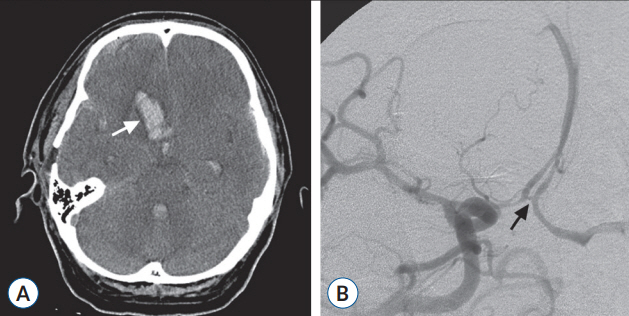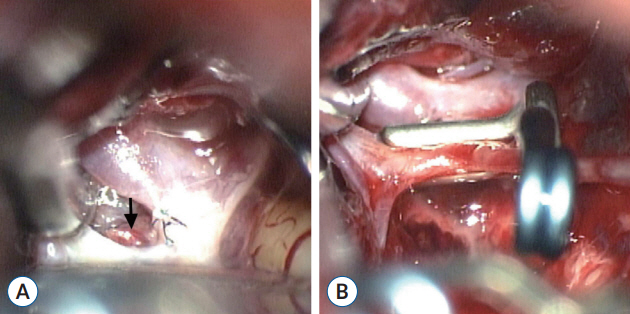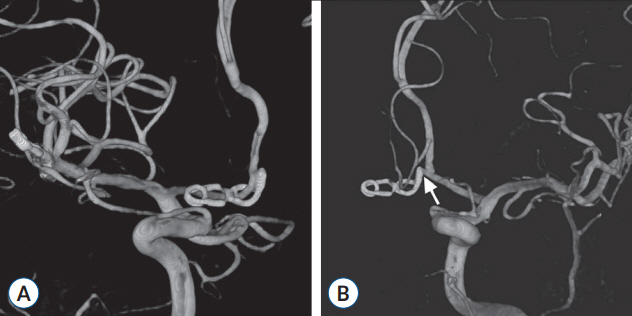J Korean Neurosurg Soc.
2024 Nov;67(6):675-681. 10.3340/jkns.2024.0069.
Successive Development and Rupture of Blister-Like Anterior Communicating Artery Aneurysms at Mirror Locations
- Affiliations
-
- 1Department of Neurosurgery, School of Medicine, Kyungpook National University, Daegu, Korea
- KMID: 2560409
- DOI: http://doi.org/10.3340/jkns.2024.0069
Abstract
- This is the first report of the successive development and rupture of blister-like anterior communicating artery (ACoA) aneurysms at mirror locations with a short interval. A 49-year-old man presented with an angiogram-negative subarachnoid hemorrhage with significant basal frontal interhemispheric blood. Surgical exploration revealed a blister-like aneurysm on the left side of the superior wall of the ACoA, which was treated using a microsuturing technique. On the 18th day after the initial subarachnoid hemorrhage, the second operation due to another angiogram-negative hemorrhage revealed a de novo blister-like aneurysm with a small blood clot on the posterosuperior wall of the ACoA close to the right A1/A2 junction. The rupture point and ACoA on the right side were occluded using an aneurysm clip. Follow-up digital subtraction angiogram at 4 years and computed tomography angiogram at 14 years after the surgery showed no recurrence or associated abnormality.
Keyword
Figure
Reference
-
References
1. Abe M, Tabuchi K, Yokoyama H, Uchino A. Blood blisterlike aneurysms of the internal carotid artery. J Neurosurg. 89:419–424. 1998.
Article2. Abiko T, Saito K, Murase M, Tomita H. Blister-like aneurysm originating from the anterior communicating artery:a case report. No Shinkei Geka. 46:207–212. 2018.3. Andaluz N, Zuccarello M. Blister-like aneurysms of the anterior communicating artery: a retrospective review of diagnosis and treatment in five patients. Neurosurgery. 62:807–811. discussion 811. 2008.4. Bradac GB, Bergui M, Ferrio MF, Fontanella M, Stura G. False-negative angiograms in subarachnoid haemorrhage due to intracranial aneurysms. Neuroradiology. 39:772–776. 1997.
Article5. Briganti F, Cirillo S, Caranci F, Esposito F, Maiuri F. Development of “de novo” aneurysms following endovascular procedures. Neuroradiology. 4:604–609. 2002.
Article6. Di Lorenzo N, Guidetti G. Anterior communicating aneurysm missed at angiography: report of two cases treated surgically. Neurosurgery. 23:494–499. 1988.
Article7. Graf CJ, Hamby WB. Report of a case of cerebral aneurysm in an adult developing apparently de novo. J Neurol Neurosurg Psychiatry. 27:153–156. 1964.
Article8. Ishikawa T, Nakamura N, Houkin K, Nomura M. Pathological consideration of a “blister-like” aneurysm at the superior wall of the internal carotid artery: case report. Neurosurgery. 40:403–405. discussion 405-406. 1997.
Article9. Jafar JJ, Weiner HL. Surgery for angiographically occult cerebral aneurysms. J Neurosurg. 79:674–679. 1993.
Article10. Kim DH, Jung JY, Lee JW, Huh SK, Lee KC. A clinical analysis of twelve cases of ruptured cerebral de novo aneurysms. Yonsei Med J. 48:30–34. 2007.
Article11. Leblanc R. De novo formation of familial cerebral aneurysms: case report. Neurosurgery. 44:871–876. discussion 876-877. 1999.
Article12. Maiuri F, Spaziante R, Iaconetta G, Signorelli F, Cirillo S, Di Salle F. ‘De novo’ aneurysm formation: report of two cases. Clin Neurol Neurosurg. 97:233–238. 1995.
Article13. Miyashita K, Nambu K, Shimizu Y, Tohma Y. Blister-like aneurysm of the anterior communicating artery treated with only low-profile visualized intraluminal support junior stent. Surg Neurol Int. 12:564. 2021.
Article14. Morris TC, Brophy BP. Blister-like aneurysm of the anterior communicating artery. J Clin Neurosci. 16:1098–1100. 2009.
Article15. Nakagawa F, Kobayashi S, Takemae T, Sugita K. Aneurysms protruding from the dorsal wall of the internal carotid artery. J Neurosurg. 65:303–308. 1986.
Article16. Ogawa A, Suzuki M, Ogasawara K. Aneurysms at nonbranching sites in the surpaclinoid portion of the internal carotid artery: internal carotid artery trunk aneurysms. Neurosurgery. 47:578–583. discussion 583-586. 2000.
Article17. Ohkuma H, Nakano T, Manabe H, Suzuki S. Subarachnoid hemorrhage caused by a dissecting aneurysm of the internal carotid artery. J Neurosurg. 97:576–583. 2002.
Article18. Peschillo S, Cannizzaro D, Missori P, Colonnese C, Santodirocco A, Santoro A, et al. Reconstructive endovascular treatment of a ruptured blood blister-like aneurysm of anterior communicating artery. J Neurosurg Sci. 61:438–441. 2017.
Article19. Qian H, Wang L, Brooks KS, Zhao X, Liu F, Sun Y, et al. Intraoperative finding of an anterior communicating artery blister-like aneurysm during a primary craniopharyngioma resection: accidental or incidental? World Neurosurg. 127:514–517. 2019.
Article20. Rouchaud A, Saleme S, Gory B, Ayoub D, Mounayer C. Endovascular exclusion of the anterior communicating artery with flow-diverter stents as an emergency treatment for blister-like intracranial aneurysms. A case report. Interv Neuroradiol. 19:471–478. 2013.
Article21. Sakaki T, Tominaga M, Miyamoto K, Tsunoda S, Hiasa Y. Clinical studies of de novo aneurysms. Neurosurgery. 32:512–516. discussion 516-517. 1993.
Article22. Seo DH, Lee WC, Choe IS, Park SC, Ha YS. Ruptured and unruptured aneurysms of the accessory anterior cerebral artery combined with a blood blister-like aneurysm of the anterior communicating artery. Neurol India. 57:85–87. 2009.
Article23. Serizawa T, Saeki N, Yamaura A. Microsurgical anatomy and clinical significance of the anterior communicating artery and its perforating branches. Neurosurgery. 40:1211–1216. discussion 1216-1218. 1997.
Article24. Sim JH, Kim SC, Kim MS. Early development and rupture of de novo aneurysm--case report. Neurol Med Chir (Tokyo). 42:334–337. 2002.25. Tatter SB, Crowell RM, Ogilvy CS. Aneurysmal and microaneurysmal “angiogram-negative” subarachnoid hemorrhage. Neurosurgery. 37:48–55. 1995.
Article26. Vincentelli F, Lehman G, Caruso G, Grisoli F, Rabehanta P, Gouaze A. Extracerebral course of the perforating branches of the anterior communicating artery: microsurgical anatomical study. Surg Neurol. 35:98–104. 1991.
Article
- Full Text Links
- Actions
-
Cited
- CITED
-
- Close
- Share
- Similar articles
-
- Microsurgical anatomy of the Anterior Cerebral-anterior Communicating Artery
- Multiple Intracranial Aneurysms: A Case Report of Patient with Nine Multiple Intracranial Aneurysms
- Technical Consideration in Clipping of the Anterior Communicating Aneurysms: The Gyrus Rectus Approach, Report of Two Operative Cases
- 2 Cases of Anterior Communicating Artery Aneurysms Associated with Visual Symptoms
- Anterior Communicating Artery Aneurysms Associated with Multiplication of Anterior Communicating Artery






